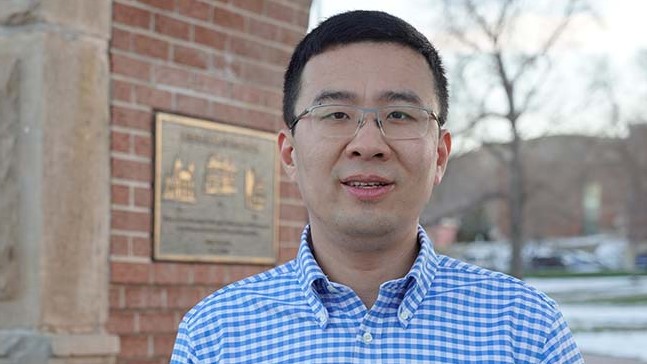South Dakota Mines Faculty Member Wins Prestigious NSF CAREER Award

This piece by South Dakota Mines was published Jan. 4, 2022.
Decades of previous biological research led to the discovery that many cells have an internal structure akin to a skeleton. This cellular skeleton, called the actin cytoskeleton, is somewhat like the bone structure in animals; it provides the rigidity needed for movement.
Congzhou Wang, Ph.D., assistant professor of nanoscience and nanoengineering at South Dakota Mines, specializes in understanding the interaction between these cellular skeletons and nano-sized particles, which are thousands of times smaller than the width of a human hair. Nanoparticles are so small that they can be easily ‘eaten’ by cells.
“We are looking at how nanomaterials change the bone structure of the cell,” says Wang. “If we break our bones, we can’t move; it’s the same way with cells. If a nanomaterial disrupts the structure of the cell, it renders it immobile.”
Wang has won a highly prestigious National Science Foundation (NSF) CAREER Award for his work, which has real promise for both stopping cancer and understanding how nanomaterials interact with the body. Read more about the NSF CAREER Award here.
Stopping Cancer
Wang aims to find nanoparticles that can attack the cytoskeleton of cancer cells, leaving them unable to metastasize and spread through the body.
“It’s usually not the primary tumor that kills you, it’s the cancer spreading to other organs,” says Wang. “Ninety percent of cancer deaths are because of the movement of cancer cells that spread and cause new tumors and we are working to stop this movement.”
Wang is seeking to find nanomaterials that can impact cancer cells without harming surrounding healthy cells. “We can design nanomaterials that can target and immobilize cancer, making it easier to treat before it spreads,” Wang says.
Wang began initial investigations and had preliminary data on breast cancer. Next, he will examine prostate and skin cancer cells. He hopes to show certain nanomaterials can be used to stop the movement of a broad range of malignant cells.
Understanding Nanoparticles in the Body
Wang is also examining how nanoparticles interact with normal healthy cells. “This is related to environmental science, because in our daily life we interact with both synthetic and naturally occurring nanomaterials. They are in our water, in the air and in many of the things we touch,” he says.
These nanoparticles can enter our blood vessels and sometimes are absorbed in the cells lining the vessel walls. Wang is examining nanoparticles that can change the bone structure of normal cells. “This is more related to the toxicity of nanomaterials,” he says. A better understanding of how various nanomaterials interact with normal human cells can help researchers understand their possible environmental and physiological impact.
In his next phase of research, Wang aims to closely examine how nanoparticles interact with the cells on the walls of blood vessels.
World-Class Research
Wang is one of three faculty at Mines to win an NSF CAREER Award since 2015.
“This is a wonderful achievement. Congratulations to Dr. Wang,” says Mines President Jim Rankin. “This prestigious award is reflective of the world-class faculty we are proud to have at Mines. This award also shows the high return on investment in university research that advances science and improves our world.”
Wang gives praise to his fellow researchers in the nanoscience and nanoengineering department at Mines. “Dr. Steve Smith, who leads the nano department and biomedical engineering at South Dakota Mines, is a very experienced researcher who has been a huge help offering suggestions for improvement in all my work, especially on the super-resolution imaging of single cells,” says Wang. He also gives high praise to his third-year doctoral student Jinyuan Liu, who has played an important role advancing the laboratory research. “Because of COVID, we have had trouble recruiting students. I have been very lucky to have Jinyuan, who has produced vital data for this grant application.”
Wang also thanks SD EPSCoR (South Dakota Established Program to Stimulate Competitive Research) for funding the purchase of the highly sensitive scientific instruments in his lab, essential for studying nanoparticle interactions in biological systems, including an atomic force microscope purchased through the EPSCoR-funded statewide bioscience research center BioSystems Networks / Translational Research (BioSNTR). Wang also participated in an NSF Early Career proposal development workshop with a consulting firm engaged by SD EPSCoR to review his NSF Career proposal before submission. Wang’s research is also funded by the National Institutes of Health and the South Dakota Board of Regents through the collaborative research award shared between SD Mines, SDSU, and USD (IMAGEN: Biomaterials Research in South Dakota) and an SDBOR competitive research award.
Inspiring the Next Generation of Researchers
Besides his work in the lab, Wang also teaches the freshman biomedical engineering course (BME 101). “This gives me an advantage because I get to work with a lot of freshmen who are eager and willing to come work in my lab,” says Wang. At Mines, undergraduate students often get a chance to do hands-on research. Wang will also work with Cassandra Birrenkott, Ph.D., who leads the SD First Program aimed at improving outcomes for first generation students. “Too often college students drop out after their first summer. Our proposal is to recruit some first-year students who can get paid and get excited about the research, and this way we can retain them,” says Wang.
 National Science Foundation RII Track-1 Project:Expanding Research, Education and Innovation in South Dakota
National Science Foundation RII Track-1 Project:Expanding Research, Education and Innovation in South Dakota